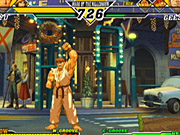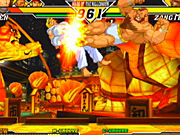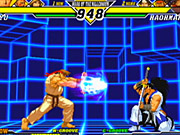The Xbox version of Capcom vs. SNK 2 EO represents what's possibly the most important achievement in fighting games since Street Fighter II was successfully ported to the Super Nintendo Entertainment System about 10 years ago. While the core game is identical to the three other versions of Capcom vs. SNK 2 released over the last year and a half for the PlayStation 2, GameCube, and Dreamcast, the Xbox version boasts one new feature that neither the previous home versions nor the arcade original had to offer: online play. Good online play. Capcom vs. SNK 2 EO technically isn't the first online-capable fighting game that's ever been made, but it's the first one to get online play right. So, as arcades have dwindled over the years and fighting games have grown less popular along with them, Capcom vs. SNK 2 EO is like a shining ray of hope for the genre. The ability to challenge other players from across the world in the Xbox version of Capcom vs. SNK 2 EO makes it an utterly incredible experience for anyone with even the faintest appreciation for the genre.

It's worth noting that online play in Capcom vs. SNK 2 EO is pretty bare-bones, though definitely serviceable. The menus are ugly, and you can't see the name of the player you're taking on in the middle of a match. But who cares? Gameplay is relatively lag-free, and that's all that really matters. An occasional hiccup in the flow of the action does crop up, but these moments tend to be few and far between, and they generally won't interrupt your timing anyway. While playing online, there's also a noticeable delay of a couple of seconds in between rounds as new characters enter the fray, but these very brief waiting periods are only noticeable since they're practically nonexistent when you're not playing online. The game seems to handle disconnecting well enough--the match registers as having been played, but no winner is declared. Players can agree to a rematch after the match is over, allowing like-minded competitors to keep going at it as long as they want. Your ranking increases as you earn wins, and the game allows you to find opponents that match your own relative skill level. What's more, the option to chat with the opponent via the Xbox Live headset--whether to compliment a well-earned victory or to talk trash--can really add a lot to the proceedings. And being able to compete against opponents both from around North America and from Japan makes Capcom vs. SNK 2 EO not just comparable to playing fighting games at the arcades, but for the most part entirely better.
The Xbox version of Capcom vs. SNK 2 EO includes the optional control scheme first seen in the GameCube version released a few months ago, a misguided attempt at making the game more newbie-friendly and easier to play on the GameCube's poorly suited controller. Using the new control scheme, you use the Xbox controller's left analog stick to move your character around, but unfortunately, the analog stick isn't nearly as precise as a directional pad--or an arcade stick, for that matter. The controller's two shoulder buttons function as pressure-sensitive punch and kick buttons, allowing you to execute basic attacks haphazardly at best. But the real kicker is that the right analog stick lets you easily perform all your character's various special moves, which normally would be executed with relatively complex combinations of controller motions and button presses.
For example, Russian wrestler Zangief's spinning pile driver, which normally requires a full-circle motion on a joystick or directional pad, is now executed simply by pressing forward on the analog stick. Charge moves such as Guile's sonic boom, which normally require you to press and hold a button or controller direction, now require no charging. Super moves are executed just as easily. Arguably, this grossly simplified control scheme opens up some new tactical possibilities--if you've ever wondered how a computer-controlled Blanka could execute his roll attack while walking forward, well, now you can actually pull off such outrageous stunts. The EO controls also sap most of the fun out of the game and make competitive play practically pointless. The character balance gets completely thrown off, as relatively hard-to-execute moves are no longer hard to execute, making some of them--like that spinning pile driver--obscenely overpowered.
Of course, the presence of the traditional six-button control scheme makes the issues with the EO controls basically irrelevant. Playing online, you can screen out opponents who prefer the EO controls and just take on traditionalists. The standard controls work pretty well with the Xbox's stock controller--the big one, not so much the controller S. The black and white buttons are lined up with the main face buttons in such a way that the controls can suitably mimic the six-button scheme found in arcades. The directional pad is a bit stiff, but it gets the job done. In short, the Xbox controller probably won't get in the way of your ability to excel at Capcom vs. SNK 2.

As a sequel, Capcom vs. SNK 2 adds some new characters, some new moves, some new game mechanics, some new backgrounds, and some new music. However, there's also a lot of the same old graphics, same old sounds, and same old gameplay. The impact of the changes made to the game will depend on how serious you are about your 2D fighters, but at any rate, Capcom vs. SNK 2 offers a great deal of variety that really shines as you take on radically different types of opponents online.
There are about 40 different characters available in the game, though of course not all of them are completely unique. Some of the better additions in this sequel include Eagle, the British stick fighter who dates all the way back to the original Street Fighter game, and Haohmaru, the cocky sword-wielding samurai from SNK's Samurai Shodown series, whose katana would presumably give him an unfair advantage. Fortunately, other characters have no problem deflecting Haohmaru's long, slow slashes with their forearms. Other notable additions include the kung fu fighter Yun, from Street Fighter III, and Rock Howard, the bastard son of Geese Howard who first appeared in SNK's Fatal Fury: Mark of the Wolves. Some of the other new characters, such as the over-the-hill martial artist Ryuhaku Todo, from SNK's Art of Fighting, and Maki, a rip-off of SNK's Mai Shiranui who appeared in the sequel to Final Fight, are surprising additions to the lineup, but they're not necessarily good ones. Capcom and SNK fans alike will probably find that they can think of a few equally rare characters they would have rather seen in the game.
The original Capcom vs. SNK let you unlock an additional version of each character that sported a different arsenal of special moves. Capcom vs. SNK 2 basically merges these "EX" characters with their standard counterparts, making for characters who for the most part have more moves and more options and are therefore generally more interesting to play. Capcom vs. SNK 2 also shows that its designers are being rather wishy-washy in deciding just how many attack buttons you can use. The Street Fighter series famously used the six-button layout of three punches and three kicks. On the other hand, NeoGeo games have always used just four buttons, and the original Capcom vs. SNK took this streamlined approach. But now, the sequel throws in with Capcom's old style. It's all well and good, since the Xbox controller provides easy access to at least six buttons.

Aside from all the characters, perhaps the most notable gameplay feature in Capcom vs. SNK 2 is the availability of six different fighting styles to choose from, compared with two in the original. The game calls these "grooves," and they're designed to mimic the gameplay styles of previous Capcom and SNK fighting games. Whether your character can perform a quick forward hop or a full run, block in midair, quickly recover from a knockdown, counter from the blocking position, and much more is governed by which groove you select. As in the original Capcom vs. SNK, you choose a team of fighters, and the groove you select applies to all of them.
The newly added grooves are interesting. The Street Fighter III-style P groove lets you parry attacks as in that game--you can tap forward as you're about to get hit, and you'll absorb the blow and have a moment to counter. The Samurai Shodown-style K groove displays a gauge that increases as your character sustains damage. When it's full, your character is in an enraged state (his or her skin turns all red), and you can dish out much more pain. This groove also gets the "just defended" system from Fatal Fury: Mark of the Wolves, which works just like parrying, only you tap backward instead of forward as you're attacked. If nothing else, the P and K grooves are fun additions to the game, though they're not as versatile as the more-conventional styles you may be accustomed to from games like Street Fighter Alpha II or King of Fighters '97. The other grooves have basically been left unchanged.
The core gameplay of Capcom vs. SNK 2 is much like that of the first game. The action still feels a bit flat--it doesn't help that the sound effects of punches and kicks aren't that great, but moreover, the game's timing isn't quite like how you might remember it in classic 2D fighters. There's not much of a stun pause when a hit connects, making most of the attacks seem very light and the timing for combos somewhat too abrupt. The ranges of normal and special moves don't necessarily correspond to what the character sprites look like they're doing. However, the controls are responsive, the gameplay is generally well balanced, and most every fighter has a good number of moves. Overall, Capcom vs. SNK 2 definitely plays very well, but it doesn't play so differently from or any better than various 2D fighting games from years past. Of course, though, the large roster of recognizable characters and online play add tremendous appeal.
Capcom vs. SNK 2 looks about the same as the original. It's been said before, but some of those characters look simply archaic at this point--one-eyed Sagat hasn't changed since Street Fighter Alpha from 1995, and Morrigan, the succubus from the Dark Stalkers series, dates back even earlier. Some of the new characters look pretty good and are smoothly animated--in particular, Eagle and Haohmaru look like the imposing fighters they're supposed to be. Others, such as the silly duo of Chang and Choi, the two Korean ex-cons from the King of Fighters series, look poor and exhibit the bland, comical art style used for some of the uglier Street Fighter Alpha characters, such as Blanka and Balrog the boxer (who are as ugly as ever in Capcom vs. SNK 2). The game's biggest graphical problem is still that the art style throughout is so inconsistent from character to character.

At least the characters all seem to blend in well with the game's attractive backgrounds, which combine fully 3D scenery with nicely drawn 2D artwork and are filled with some really obscure references to some of Capcom's and SNK's older games. It's too bad that the tastefully done introduction animations used for the original Capcom vs. SNK stages are nowhere to be found in the sequel. Likewise, there's no real semblance of a story and no real character endings. Capcom vs. SNK 2 recycles most of the speech and sound effects from the first game, and the all-new music mostly consists of the same sort of forgettable but occasionally grating dance beats found in the original. However, a couple of these tracks are quite good and actually use vocals to good effect. But you may find yourself wanting to turn off most of the vocals anyway, because of the game's irritating albeit fluently English-speaking announcer.
Between its release in arcades and its releases for the PS2, GameCube, and Dreamcast, Capcom vs. SNK 2 has already proven to be a successful sequel with fans of the original, as well as with many fans of both companies' previous efforts. So it's ironic that, despite the game itself being exactly the same for the Xbox as for all other platforms, the Xbox version stands out as such a remarkable achievement. What could have been yet another multiplatform hand-me-down has become nothing short of a revolutionary achievement in fighting games thanks to the successful implementation of online play. Fans of the genre yearning for some real competition absolutely need to own this game.